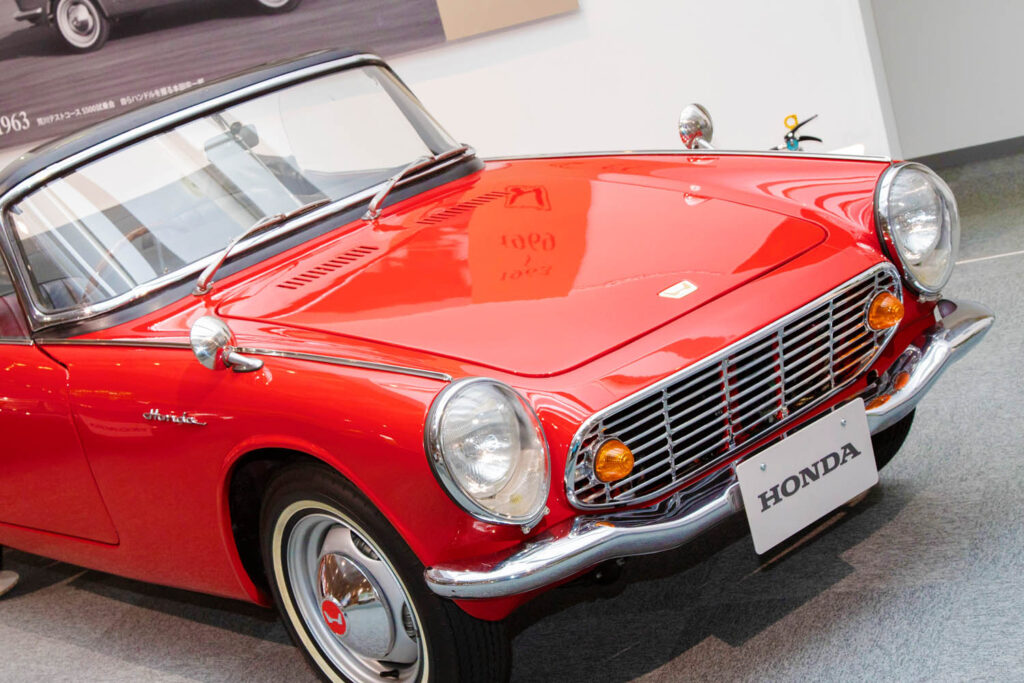S600, still popular as a mainstay of the Japanese classic car hobby
Honda is a manufacturer with a long-established image for its motorsport activities. The pioneers of this on four wheels for Honda were the S600, which debuted in 1964, and the S800, which took over the baton in 1966.
Honda launched a succession of four-wheeled sports cars to ensure its survival
It was in 1962 that Honda publicly announced its departure from the two-wheel manufacturer it had been to become a four-wheel manufacturer, both at home and abroad. This was also the year that the Suzuka Circuit was completed, and the year before, Mike Hailwood had won the Isle of Man TT race for the first time pinnacle of the motorbike world, at least. At the 9th All Japan Motor Show in October 1962, Honda unveiled two four-wheelers. These were the T360 and the Sports 360.
There was a reason why Honda publicly announced the production of four-wheelers. The so-called ‘Temporary Measures Bill for the Promotion of Specific Industries’ was to be debated in the Diet, which would consolidate Japanese car manufacturers into three groups led by Toyota and Nissan to give them strength in the wake of the upcoming capital liberalization by MITI, and if this bill was passed, new manufacturers would not be allowed to enter the market. This bill would make it impossible for new manufacturers to enter the market. Soichiro Honda had a heated argument with Shigeru Sahashi, who was then the vice-minister of MITI, but the bill was passed quietly, and Honda built two cars to create an existing situation to break the deadlock.
However, while the T360 went on sale, the Sports 360 never saw the light of day. The reason was that “360cc is not world-class”. As a result, the Sports 360 made its market debut in October 1963 as the S500, with a larger chassis and higher displacement, and only six months later the S600, with a further 100 cc increase, was born. This was the background to the hasty launch of the car.
The Honda S600 was introduced in March 1964, with the S800 replacing it from January 1966. Then, in May 1966, the rear chain drive was replaced by a normal coil spring and rigid axle, so the chain-driven S800 was in production for just over four months. The final model was known as the S800M, and was more luxurious, with a radio and other equipment, as well as disc brakes at the front and 13-inch radial tyres.
The S600 won its class at the Nurburgring! It put Honda on the world map
The S600/S800’s rampage on the circuit is evident from the race records of the time, but the S600 in particular is still talked about as the first Honda four-wheeled car to win a race overseas. In 1964, when Formula One was already underway, one of the three S600s sent to Europe won its class in the Nürburgring 500 km race. The entrant was Jack Brabham and the driver was Dennis Hulme. The duo would later lead Brabham Honda to 11 consecutive victories.
The winning car was subsequently displayed at the Tokyo Motor Show. As far as I have been able to find out, the car still exists and is still in Japan. However, this Nürburgring winner looks a little different compared to the production S600. The most visible difference is the front grille. The car that competed in the Nurburgring was an S600, but the grille on it was that of an S500.
The production models of the time also varied, with or without a backup lamp inside the rear combination lamp. The very early S600s also had a different engine.
Aside from the racing success of the S600/800, there is also the famous story of Grace Kelly, the famous actress-turned-queen of Monaco, who used an S800 as her private car. It is no exaggeration to say that the Honda S600/800 is the car that made Honda known to the world.
S800 bulge was ‘decoration’ !?
The S800 took its performance to the next level. The grille is still a distinctive feature of the exterior. According to the designers of the time, it was based on the grille of the Ford Mustang. The power bulge was fitted as a sign of high performance, but it seems to have been for appearance only: Takashi Miyazawa, who joined Honda in 1959 and was assigned to the Sculpting Department, recalls that he admired the Triumph TR4 and had the bulge fitted, but that it was just for decoration. The other reason he was told was to clear the carburetor, but it seems to have been an afterthought.
Honda at the time was thus full of energy to realize Soichiro Honda’s dream as his own: at the 20th anniversary of Suzuka in 1983, Soichiro Honda drove the Curtis, which he had once driven and raced, around Suzuka. As he got in, he said to me with a straight face, “Do you think I can drive it?” I felt as if he had said it to me with a straight face, but apparently, he was saying it to the person next to him. Nevertheless, I still remember his high-pitched voice with vitality and his piercing, penetrating gaze.
translated by DeepL
